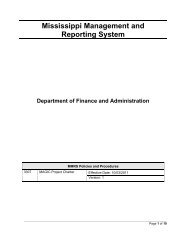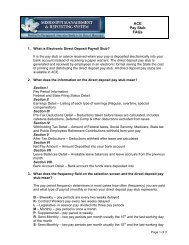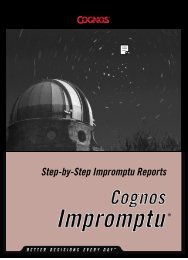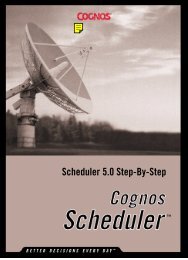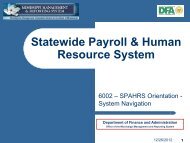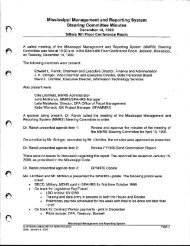10/12/2011 FIN 01 Overview of SAP FI Master Data - Mississippi ...
10/12/2011 FIN 01 Overview of SAP FI Master Data - Mississippi ...
10/12/2011 FIN 01 Overview of SAP FI Master Data - Mississippi ...
Create successful ePaper yourself
Turn your PDF publications into a flip-book with our unique Google optimized e-Paper software.
1.7 Each data element represent a separate dimension <strong>of</strong> data. Goal is to create these in <strong>SAP</strong> without<br />
combining them. Each <strong>of</strong> these data elements should be independent<br />
2. High Level Organization<br />
2.1 Company Code= highest organization structure for financial accounting and control purposes, e.g.<br />
State <strong>of</strong> <strong>Mississippi</strong><br />
Chart <strong>of</strong> Accounts- your balance sheet and revenue objects (just the GL account itself)<br />
Why one company code Eliminates redundancy<br />
2.2 Business Area = used to represent agencies, lines <strong>of</strong> business, or locations for which full financial<br />
statements are required. Commonly used for major organization divisions, e.g. SoMS Agencies.<br />
2.3 Controlling area= highest organization structure for cost controlling; defines organizational span for<br />
cost reallocations. Recommend one controlling area for MS is to have one controlling area.<br />
2.4 Funds Management Area= Highest organizational structure for budgeting; span <strong>of</strong> control for<br />
budgeting. Bottom line- there is one <strong>of</strong> these- this is the entire organization. All US publis sector<br />
customers <strong>of</strong> <strong>SAP</strong> have 1 funds management area. <strong>SAP</strong> team recommends 1 funds management area<br />
for SoMS.<br />
3. Introduction to Lower Level <strong>Master</strong> <strong>Data</strong> in each Module<br />
3.1 Derivation: Will we have to enter in all these fields manually No, <strong>SAP</strong> derives most <strong>of</strong> these<br />
automatically and populates codes based on a series <strong>of</strong> rules built into <strong>SAP</strong>. One <strong>of</strong> the requirements for<br />
<strong>Mississippi</strong> is to default as much as possible.<br />
3.1 (note - duplicate numbering in slides) Financial accounting<br />
GL account- asset, liability, fund balance, expense, or revenue category in <strong>FI</strong>. Mapping will be a<br />
critical part in the implementation<br />
FM Budget Period- used with fund, comes into play during the “lapse period” <strong>of</strong> July and August<br />
3.2 Controlling<br />
Project master data is typically maintained at the agency level. The required fields can be agency<br />
specific.<br />
3.3 Funds Management <strong>Master</strong> <strong>Data</strong><br />
Commitment Item - expense/ revenue category, typically derived 1:1 from expense and revenue GL<br />
accounts<br />
Fund- Represents funding source. Funds can be numbered to facilitate roll-up for reporting and<br />
budget control. Can also have attributes for consolidated reporting, e.g. CAFR. Raised question<br />
about difference between fund as used in <strong>SAP</strong> and current use <strong>of</strong> fund by SoMS. (Will be discussed<br />
in detail in workshop <strong><strong>FI</strong>N</strong>_04.)<br />
Fund center- organizational structure, usually derived from cost center, and number hierarchically.<br />
3.4 Grants Management <strong>Master</strong> <strong>Data</strong><br />
Sponsored class- expense and revenue categories required by grantor(s). Derived from GL<br />
accounts.<br />
Fund – same funding dimension used by other modules<br />
Sponsored Program- Occasionally a grantor wants you to report on a program that means something<br />
to them, this is the oddball dimension and we can break it up using this tool. It is very flexible, and not<br />
intuitive<br />
4



